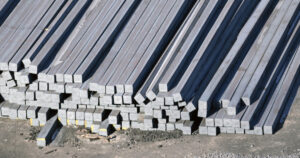
In January-April of this year, Ukraine increased exports of processed cast iron in physical terms by 37.4% compared to the same period last year, to 574,057 thousand tons from 417,941 thousand tons.
According to statistics released by the State Customs Service (SCS) on Tuesday, during the period in question, exports of pig iron in monetary terms increased by 46% to $226.282 million.
Exports were mainly to the US (83.05% of shipments in monetary terms), Italy (11.34%), and Poland (2.7%).
In the first four months of the year, the country imported 29,000 tons worth $55,000 from Brazil (68.52%) and Germany (31.48%), while in January-April 2024, 15 tons of pig iron worth $35,000 were imported.
As reported, on March 12 of this year, in accordance with a decision by President Donald Trump, the US began imposing a 25% tariff on imports of Ukrainian steel products, except for pig iron.
In 2024, Ukraine reduced exports of processed pig iron in physical terms by 3.4% compared to 2023, to 1 million 290.622 thousand tons, and in monetary terms by 6.1%, to $500.341 million. Exports were mainly to the US (72.64% of shipments in monetary terms), Turkey (8.03%), and Italy (7.30%).
In 2024, the country imported 38 tons of pig iron worth $90 thousand from Germany, while in the same period of 2023, it imported 154 tons of pig iron worth $156 thousand.

In January-April this year, Ukraine reduced exports of semi-finished carbon steel products in physical terms by 24.6% compared to the same period last year, to 440,036 thousand tons.
According to statistics released by the State Customs Service (SCS) on Tuesday, in monetary terms, exports of carbon steel semi-finished products fell by 25.3% to $215.286 million.
The main exports were mainly to Bulgaria (40.65% of supplies in monetary terms), Turkey (18.46%), and Poland (13.59%).
During the period in question, Ukraine imported 3,303 thousand tons of semi-finished products worth $2.687 million, mainly from the Czech Republic (72.47%), Italy (26.26%), and Romania (0.93%).
As reported, in 2024, Ukraine increased exports of semi-finished products made of carbon steel in physical terms by 56.7% compared to 2023, to 1 million 886.090 thousand tons. The main export destinations were Bulgaria (32.06% of shipments in monetary terms), Egypt (18.50%), and Turkey (11.14%).
In 2024, Ukraine imported 306 tons of semi-finished products worth $278 thousand from the Czech Republic (88.13%), Romania (7.19%), and Poland (2.88%), while in 2023, it imported 96 tons worth $172 thousand.

The company “Ma’Rizhany Hemp Company” (Zhytomyr region) has commissioned a plant for processing industrial hemp with a capacity of 14,000 tons per year in the “Ma’Rizhany” industrial park, according to the Ministry of Economy.
“The development of domestic processing is one of the key tasks of the government’s “Made in Ukraine” policy and part of the national economic concept. We must change the structure of the economy from raw materials to high technology and increase the production of high value-added goods,” said First Deputy Prime Minister and Minister of Economy of Ukraine Yulia Svyrydenko during an introductory visit, as quoted in the report.
The plant will produce long fibers for textiles and technical fabrics (for export, with the prospect of processing within the country for the Ukrainian fashion industry); short fibers for paper, nonwoven materials, insulation, and straw will be used as raw materials for bioplastics, construction materials, and animal bedding.
According to a Facebook post by Dmytro Kysilevsky, deputy head of the parliamentary committee on economic development, who was present at the opening of the plant, the investment in the first phase of the project exceeded $20 million. The plant currently employs 200 people.
According to information from the company, cited by the Ministry of Economy, in the 1990s, the processing of bast crops in Ukraine virtually disappeared, and with it, the production of combed yarn. This made the textile industry dependent on imports and reduced its competitiveness.
To change the situation, in 2023, Ma’Rizhani Hemp Company began renovating the abandoned flax factory. In 2024, the company planted 890 hectares of industrial hemp, and in 2025, 1,200 hectares.
“This is the largest area under hemp cultivation in Central and Eastern Europe,” the report says.
Currently, the production area is 10,000 square meters, the warehouse area is 10,800 square meters, the construction and installation of equipment has been completed, and testing of raw materials and the production of the first samples has begun. As reported, IP “Ma’Rizhany” occupies about 30 hectares, the territory of a former flax processing plant. It will be the first park in Europe for the primary processing of bast crops. It was entered in the Register of IPs in August 2024. It is planned to create more than 700 jobs.

Following the signing of a cooperation agreement between Ukraine and the US in the field of mineral resources, the world community’s attention has been focused on Ukraine’s potential for rare earth element (REE) extraction. These elements are critical for modern technologies, including the production of electric vehicles, wind turbines, and defense equipment. However, experts caution against excessive optimism about the rapid realization of this potential.
Volodymyr Khaustov, scientific secretary of the State Institution “Institute of Economics and Forecasting of the National Academy of Sciences of Ukraine,” honored economist of Ukraine, and candidate of technical sciences, shared his vision of the prospects for REE mining in Ukraine.
“Ukraine does indeed have certain reserves of rare earth elements, but most of them were explored during the Soviet era, and this data needs to be updated. In addition, a significant portion of potential deposits are located in areas currently under Russian control or near the combat zone,” Khaustov noted.
The expert also highlighted the technological and infrastructural challenges associated with the extraction and processing of REEs.
“Even if we can gain access to these deposits, the question of their economic viability arises. REE extraction is a complex and expensive process that requires modern technology and significant investment. At present, Ukraine does not have the necessary infrastructure for the full cycle of extraction and processing of these elements,” he explained.
It should be noted that, according to research, only one of the six known REE deposits in Ukraine — Novopoltavskoye in the Zaporizhzhia region — has confirmed reserves and is open for licensing. However, even this deposit requires an investment of about $300 million for full development.
In addition, the global REE processing market is currently dominated by China, which controls about 90% of the world’s capacity for the purification and processing of these elements. This creates additional challenges for countries seeking to develop their own REE production.
“For Ukraine to become competitive in the global REE market, it is necessary not only to develop deposits, but also to create a complete value chain — from extraction to processing and manufacturing of end products. This requires strategic planning, significant investment, and time,” Khaustov emphasized.
In conclusion, although Ukraine has potential in the field of rare earth element extraction, realizing this potential requires a comprehensive approach, significant resources, and time. Experts call for cautious optimism and strategic planning to achieve success in this industry.
For more details on the prospects for rare earth extraction in Ukraine, watch the video: https://www.youtube.com/watch?v=UHeBfpywpQc&t
You can subscribe to the Experts Club channel at: https://www.youtube.com/@ExpertsClub
ECONOMY, EXPERT, EXPERTS CLUB, INDUSTRY, rare earth elements, rare earths, Volodymyr Khaustov

As of May 12, Ukraine had exported 37.064 million tons of grains and legumes since the beginning of the 2024-2025 marketing year (July-June), of which 1.796 million tons were shipped this month, according to the press service of the Ministry of Agrarian Policy and Food, citing data from the State Customs Service of Ukraine.
According to the report, as of May 17 last year, total shipments amounted to 44.214 million tons, including 2.856 million tons in May.
In terms of crops, since the beginning of the current season, 14.467 million tons of wheat (564,000 tons in May), 2.286 million tons of barley (19,000 tons), 10,800 tons of rye (0), corn – 19.755 million tons (1.206 million tons).
Total exports of Ukrainian flour since the beginning of the season as of May 16 are estimated at 61,000 tons (3,300 tons in May), including wheat flour – 57,600 tons (3,200 tons).